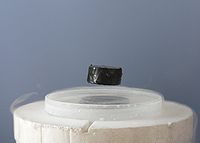
Photo from wikipedia
We calculate the current–phase relation (CPR) of a SN-S-SN Josephson junction based on a SN bilayer of variable thickness composed of a highly disordered superconductor (S) and a low-resistivity normal… Click to show full abstract
We calculate the current–phase relation (CPR) of a SN-S-SN Josephson junction based on a SN bilayer of variable thickness composed of a highly disordered superconductor (S) and a low-resistivity normal metal (N) with proximity-induced superconductivity. In such a junction, the N layer provides both a large concentration of phase in the weak link and good heat dissipation. We find that when the thickness of the S and the N layer and the length of the S constriction are about the superconducting coherence length the CPR is single-valued and can be close to a sinusoidal shape. The product IcRn can reach Δ(0)/2|e| (Ic is the critical current of the junction, Rn is its normal-state resistance, Δ(0) is the superconductor gap of a single S layer at zero temperature). Our calculations show, that the proper choice of the thickness of the N layer leads both to nonhysteretic current–voltage characteristics even at low temperatures and a relatively large product IcRn.
Journal Title: Beilstein Journal of Nanotechnology
Year Published: 2020
Link to full text (if available)
Share on Social Media: Sign Up to like & get
recommendations!